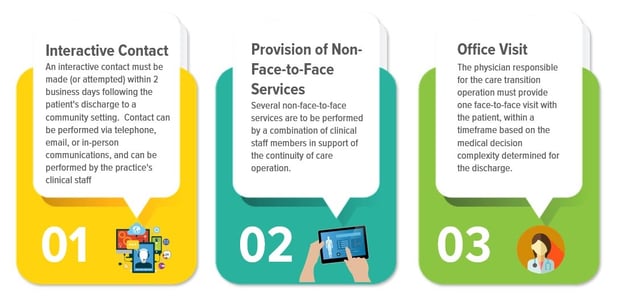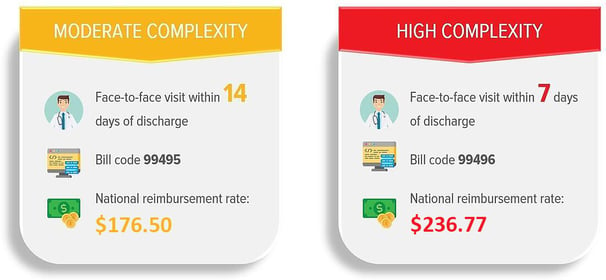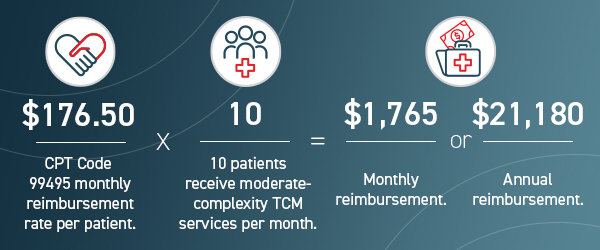What Are the 2022 CPT Codes for Transitional Care Management?
Medical reimbursements are tied to Current Procedural Terminology (CPT) codes. They categorize and specify billing rates and rules for procedures, treatments, and care services.
If you’re a medical care provider, you likely know this. But do you know the rates and workflows for Medicare’s wellness programs? Like, Transitional Care Management (TCM)?
Knowing the billing codes for TCM will give you a better idea of what’s expected, both by the patient and Medicare.
Understanding billing codes will also help you project revenues and optimize your staff’s capacity. Without this information, you risk disorganization and a clouded outlook.
At ThoroughCare, we’ve worked with clinics and physician practices across the US to help them streamline and capture Medicare reimbursements. Our software solution assists with TCM’s rules and regulations, and it tracks all activities related to providing the program, making it easier to bill for.
In this article, we’ll briefly review the requirements of TCM, as well as the program’s CPT codes. We’ll also provide an example return-on-investment (ROI) of an effective TCM program.
With this information, you’ll better understand TCM billing expectations and standards. You’ll also see how care coordination software can simplify the program.
How Does Transitional Care Management Work?
TCM provides for patients in the first 30 days after a hospital discharge. The goal is that the patient avoids readmission and has a successful transition home.
The patient’s hospital discharge must be from one of the following settings:
- Inpatient acute care hospital
- Inpatient psychiatric hospital
- Long-term care hospital
- Nursing home
- Inpatient rehabilitation center
- Hospital outpatient observation/partial hospitalization
Primary care doctors and specialists, as well as non-qualifying medical practitioners, may offer TCM services. This consists of three segments.
They are interactive contact, non-face-to-face services, and office visit. Unless determined to be unnecessary, all segments are mandatory within a specific timeframe. To learn more about the specifics of each of these segments, refer to the following graphic. Or, read more about the rules and regulations of TCM.

CPT Billing Codes for Transitional Care Management
For 2025 reimbursement information, click here.
Once all three service segments of TCM are provided, billing may commence.
There are two CPT code options for TCM. Only one can be billed per patient per program completion. The most appropriate to use depends on how complex the patient’s medical decision-making is.

Medical decision-making refers to the difficulty of establishing a diagnosis and/or selecting a care management option. Its complexity is determined by the following factors:
- How many possible diagnoses and/or the amount of care management options need to be considered
- The breadth and/or complexity of medical records, diagnostic tests, and/or other information that needs to be acquired and analyzed
- The risk of significant complications, morbidity, and/or mortality as well as comorbidities associated with the patient’s presenting problem(s), the diagnostic procedure(s), and/or the possible management options
Both CPT code options account for medical decision-making, separating it by moderate or high complexity. At the provider’s discretion, one of the following can be used for TCM billing:
- CPT Code 99495 – TCM services with moderate medical decision complexity (face-to-face office visit occurs within 14 days of discharge). National average: $176.50.
- CPT Code 99496 – TCM services with high medical decision complexity (face-to-face office visit occurs within 7 days of discharge). National average: $236.77.
Please note: Office visits are part of the overall TCM service. Do not bill them separately.
ROI of a Transitional Care Management Program
While the phrase return on investment (ROI) holds a financial connotation, a “return” isn’t entirely dependent on monetary value. General benefits are equally important, especially with regard to a person and their health.
Patients benefit from TCM for its attention to their health at a critical juncture.
According to the American Journal of Medical Quality, patients decreased their odds of hospital readmission by nearly 87% when they participated in the program. That’s nothing to shrug at.
On the provider side, this benefit plays right into the goal of value-based healthcare, while minimizing overall healthcare costs.
Reduced readmissions help satisfy certain performance indicators measured by Medicare.
This can help providers sustain or improve their Merit-based Incentive Payment System (MIPS) score, which can raise reimbursement rates.
How Can Transitional Care Management Produce Revenue?
As for TCM reimbursement rates, what is the revenue opportunity of the program?

This figure does not account for staff wages. That said, it’s likely your practice already provides some of the services inherent to TCM upon a patient’s hospital discharge.
Offering these services as a TCM program can recover costs and standardize certain processes. This will make them more effective for the patient.
Streamline TCM With Care Coordination Software
To deliver the three segments of TCM, you’ll want a system in place to manage your program.
A practical resource, such as care coordination software, will keep key details from being lost or overlooked. This will promote efficiency for you and your staff and help patients succeed.
Care coordination software can streamline patient scheduling, support documentation, and guide staff with workflows. ThoroughCare’s software solution offers these exact features. With a clinician’s eye, we’ve designed an intuitive platform that simplifies the entire TCM process. It also enables you to offer a whole suite of wellness services.
While TCM can be a time-consuming effort, it is less so with the right tools.



